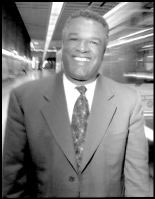THE SEATTLE City Council’s annual navel-gazing session almost imploded before it began last week. Once under way, however, the council’s retreat did give Seattle’s lawmakers some important information as they begin to fight for their political relevance. The legislative arm of city government faces a very real threat to its power if Mayor Greg Nickels and a powerful coalition of activists can convince voters to support an initiative that would force council members to represent neighborhood wards rather than Seattle at large.
The City Council’s annual retreat has been controversial for years. Every January, the nine council members, their personal aides, and the council’s central staff retire from public scrutiny to a bucolic location for a couple of days for team-building exercises and workshops.
This year, when City Council President Peter Steinbrueck hired political consultant Cathy Allen to lead a media/communication workshop at the retreat, all hell broke loose. Two days before the retreat began, Judy Nicastro and progressive stalwart Nick Licata publicly charged that Steinbrueck had misused city money. “Improving elected officials’ images so they can keep their jobs is not a proper use of public money,” said Nicastro. Her complaint seems irrefutable—private sources of money are readily available to council members for burnishing images. Moreover, Nicastro claimed that paying more than $6,000 to Allen, who has done campaign work for several council members, created a conflict of interest. “How can [Allen] take public dollars when [she] may be taking money from elected officials when they are candidates?” Again, Nicastro’s thrust was difficult to parry: Allen is a controversial figure who has attracted concern more than once for the dizzying array of hats she wears in her work. Is she a TV and radio pundit? A spin doctor for candidates? A neutral consultant to government? She wants to be all of those and more.
Ultimately, however, neither Nicastro nor Licata claimed any laws or ethics regulations were broken, and everybody traipsed off to the retreat at the Cedar River Watershed Education Center, a gorgeous city facility near North Bend.
Allen’s four-hour presentation on communication and media strategies left little doubt that she’d worked hard for her money. She did a good job analyzing the council’s PR problem, but crafting solutions for this fractious bunch escaped her.
Allen and her staff analyzed 1,200 articles in local newspapers about the City Council, held focus groups, and conducted polls. The focus groups revealed a lot about what Seattleites think of their council. The good news from Allen is that her focus groups believe the council is honest, hardworking, and smart; they like the fresh ideas and healthy variety of opinions expressed by the current group. On the downside, Allen found that her sample citizens believed the council works too much on tangential issues and is too elitist and liberal. Information gleaned from the focus groups and polling done by Allen over many years shows an alarming trend for the city’s legislators: The Seattle voters’ overall approval rating of the City Council has dropped precipitously in recent years from highs in the 70s and 80s to a recent low of less than 50 percent.
There are other tangible indications of this dissatisfaction. In last September’s primary, two council incumbents, Richard Conlin and Richard McIver, received less than 50 percent of the vote, a real change from incumbents’ stratospheric numbers in the past. While both went on to win in November, the message is clear—there’s a growing unrest among Seattle’s citizenry.
Usually it’s hard for this kind of general grousing to achieve coherence, but the coming initiative on district elections gives the dissatisfaction a real outlet.
Currently, all nine members of the council are elected citywide. This makes them into minimayors and diffuses the authority of Seattle’s chief executive. City government has a balance of power that provides vital checks and balances. Neighborhood activists argue, however, that expensive citywide elections allow council members to ignore basic services and poorer parts of the community in favor of the deep-pocketed downtown business boosters and their trophy projects.
Last fall, longtime rabble-rouser Jay Sauceda launched an initiative for the 2003 ballot to change the way Seattle elects its council members—from citywide to neighborhood-based districts. Sauceda’s effort seemed pretty half-baked at first, but now he has some very powerful allies. Mayor Greg “my way or the highway” Nickels is backing Sauceda’s initiative and has promised to lend his considerable financial and political resources. Last week, Yes for Seattle, a group of respectable radicals—political consultants, lawyers, and professional organizers—pledged that if Sauceda has any trouble collecting signatures, they would step in and get the job done.
All this means the City Council must grapple with its poor public image or lose power. Some members, like Licata, argue that district elections are the solution to the problem. The council members who disagree will have to hire a spin doctor— on their own time and nickel—to craft a message that the status quo is worth preserving.








